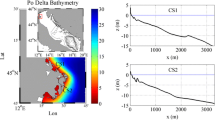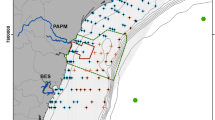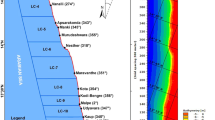Abstract
The results of analysis of climatic peculiarities of the alongshore fluxes of bottom sediments are presented. The object of research is the coastal zone of the Hicacos Peninsula in the northern part of Cuba. The main goal of this work is to analyze the peculiarities of alongshore transport of bottom sediments in the region of the Hicacos Peninsula in the period from 1990 to 2019. Components of surface waves are considered as a transport mechanism: pure wind waves and swell. The research method is mathematical modeling. The parameters of surface waves were estimated using the modern DHI MIKE 21 SW spectral wave model. A mathematical model, which calculates the fluxes of noncohesive material under the influence of wind waves, is used to estimate the volumes of transported bottom sediments. It was estimated that the annual mean (climatic) values of the fluxes from east to west are 45 000 m3/year, while those from west to east are about 11 000 m3/year. The contribution of individual tropical cyclones to the annual fluxes can be very significant; they are measured in tens of percent.











Similar content being viewed by others
REFERENCES
N. N. Dunaev, I. O. Leont’yev, and J. L. J. Marti, Oceanology 60 (4), 542–548 (2020).
N. N. Dunaev, I. O. Leont’yev, T. Yu. Repkina, and J. F. Herrera, Uch. Zap. Ross. Gos. Gidrometeorol. Univ., No. 50, 152–169 (2018).
I. Mitrani-Arenal, A. Perez-Bello, J. Cabrales-Infante, Y. Povea-Perez, M. Hernández-Gonzalez, and O. Diaz-Rodriguez, Rev. Cubana Meteorol. 25 (2), 121–138 (2019).
A. Pérez-Bello, I. Mitrani-Arenal, O. Diaz-Rodríguez, C. Wettre, and L. Hole, Rev. Cubana Meteorol. 25 (1), 109–120 (2019).
V. S. Medvedev and J. L. Juanes, Morpholithodynamical researches in the littoral zone and at shelf of Cuba northern bank, in Continental and Island Shelfs. Relief and Depositions (Nauka, Moscow, 1981), pp. 229–251 [in Russian].
N. N. Dunaev, I. O. Leont’yev, T. Y. Repkina, and J. L. J. Marti, Springer Geol. 1, 83–92 (2020). https://doi.org/10.1007/978-3-030-38177-6_10
MIKE 21, Spectral Wave Module, DHI Water & Environment, 2007.
B. Divinsky and R. Kosyan, Cont. Shelf Res. 136, 1–19 (2017). https://doi.org/10.1016/j.csr.2017.01.008
B. Divinsky and R. Kosyan, Oceanologia 60, 277–287 (2018). https://doi.org/10.1016/j.oceano.2017.11.006
K. Taylor, J. Geophys. Res. 106, 7183–7192 (2001).
M. S. Longuet-Higgins, J. Geophys. Res. 75, 6788–6801 (1970).
M. Larson, L. X. Hoan, and H. Hanson, J. Waterway, Port, Coast, Ocean Eng. 136 (2), 119–122 (2009).
S. Zou, R. Dalrymple, F. Asce, and B. Rogers, in Proc. 5th Int. Symp. on Ocean Waves Measurement and Analysis Waves-2005 (Madrid, 2005), pp. 186–192.
T. Walton, Coastal Engineering Manual, Part III: Coastal Sediment Processes, Engineer Manual 1110-2-1100 (U.S. Army Corps of Engineers, Washington, 2002), Chapter III-6, p. 72.
R. Kos’yan, Coast. Eng. 9, 171–187 (1985).
J. G. Jonsson, On the existence of universal velocity distributions in an oscillatory, turbulent boundary layer, in Report No. 12 of Coast. Eng. Lab/Hydraul. Lab. (Tech. Univ. Denmark, 1966), pp. 2–10.
A. D. Ashton and A. B. Murray, J. Geophys. Res. 111, F04011 (2006). https://doi.org/10.1029/2005JF000422
C. M. González-Ramirez and L. E. Guadalupe, Rev. Cubana Meteorol. 25 (3), 469–480 (2019).
Funding
This problem was formulated according to a State Assignment (project no. 0149-2019-0005), and was supported by the Russian Foundation for Basic Research (project no. 18-55-34002), analysis of the experimental data was supported by the Russian Science Foundation (project no. 20-17-00060), and the mathematical modeling and computational part was performed with the support of grants from the Russian Foundation for Basic Research (project nos. 18-05-80035, 19-05-00041, and 19-45-230002). The analysis of the results was supported within the framework of program no. 0149-2019-0014 and by the Russian Foundation for Basic Research (project no. 20-05-00009).
Author information
Authors and Affiliations
Corresponding author
Additional information
Translated by E. Morozov
Rights and permissions
About this article
Cite this article
Divinsky, B.V., Dunaev, N.N. & Kosyan, R.D. Alongshore Fluxes of Sand Sediments in the Region of Propagation of Tropical Cyclones (Example of the Hicacos Peninsula, Cuba). Dokl. Earth Sc. 497, 328–340 (2021). https://doi.org/10.1134/S1028334X2104005X
Received:
Revised:
Accepted:
Published:
Issue Date:
DOI: https://doi.org/10.1134/S1028334X2104005X




